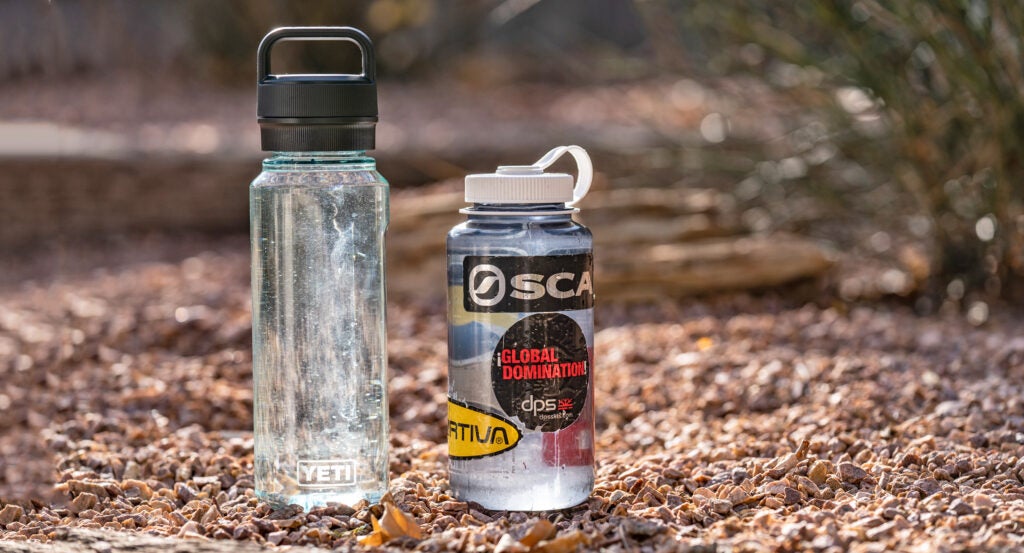No products in the cart.
Outdoor Adventure
First Look: Yeti Yonder Water Bottle
Outside’s long reads email newsletter features our strongest writing, most ambitious reporting, and award-winning storytelling about the outdoors.
To be honest, I’m mostly a summer Yeti kind of person. I rely on their coolers and insulated water bottles during the heat to keep everything cold. And damn, their products are good at keeping things cold.
But when winter rolls around, most of my Yeti stuff stays in the garage. For a water bottle I switch over to my trusty, 10-year-old Nalgene. I don’t need the extra weight of an insulated metal bottle, I just want something to carry water. My Nalgene mostly lives in my uphill and backcountry ski bag because I trust it to never leak onto my down jacket.
The smart folks at Yeti obviously realized that there were more people like me and that they were losing out when it comes to lightweight, non-insulated bottles. And thus, we have the new Yonder. It comes in two sizes, 25 and 34 ounces, and I’ve been drinking out of both of them wondering if the Yonder will ever replace my Nalgene.
The short answer is: I’m not sure. There are a couple differences between the Yonder and the Nalgene, but overall, the bottles are pretty similar. Your choice will be completely based on personal preference.
One main difference is the shape. The 34-ounce Yonder bottle is thinner and taller than the standard 32-ounce wide-mouth Nalgene bottle and one side is flattened—that might make a difference for ski nerds who think the Yonder fits better in a backcountry pack. For most people, the thinner 34-ounce bottle is not going to be any easier to grip in one hand than a 32-ounce Nalgene.
The two-part Yonder Cap that comes on both versions of Yeti’s bottle is a clear advantage. Screw off the entire cap and you can drink from the bottle or get a brush inside for cleaning. Screw off just the handle, but leave on the base of the cap, and you get a narrow drink spout. The system is totally leakproof (I can verify) and easier to drink from than the wide-mouth Nalgene when you’re on the go, like in the car or on a ski lift. The handle on the Yonder Cap is also stronger than the lid strap that comes on a Nalgene. This means you can strap the Yonder to your backpack and never worry that it’s going to fall off.
In terms of durability, there’s no doubt that a Yonder bottle will last the rest of your life—unless maybe it rolls off a cliff or gets run over by a dump truck. The bottles are made from what Yeti calls a “BPA-free material,” which appears to be a standard plastic. On the other hand, Nalgene says that by the end of 2022 they plan to have their entire BPA/BPS-Free bottle product line made from “material derived from 50-percent recycled content.” That’s a checkmark in Nalgene’s column.
So, should you switch? One thing that might steer people toward Nalgene is the price. The 34-ounce Yonder costs $28, or nearly double the $16 it will cost you to get a 32-ounce wide-mouth Nalgene. And the $16 I’m quoting is actually for their Sustain bottle that’s made from 50 percent recycled content. If you want a standard Nalgene you can get it for as little as $9.
Nalgene’s also come in a huge variety of colors (I saw 28 choices on their site). The company regularly collaborates with other brands and organizations so you can currently get a bottle with the NASA logo or one where proceeds go to benefit a clear water fund for the Navajo Nation.
And, of course, many people will be plenty happy to keep their Nalgene because these bottles become a diary of adventures. Every time I pull out my Nalgene, I’m reminded of the many different ski trips it’s been on. All those scrapes, scratches, and stickers are fond memories and reminders that I don’t just sit at home and write about gear but actually spend plenty of time playing outside.
Nalgene has been around for 70-plus years so they admittedly have a big head start when it comes to plastic bottle brand loyalty. My guess, however, is that soon enough Yeti will start to eat away at their dominance. Yeti is great at iteration, so the Yonder will likely evolve and we’ll have more reasons to choose their bottle instead of a Nalgene. And it will take a few years, but eventually, you’ll start seeing Yonder bottles with the same patina of scratches and stickers—and those bottles, too, will be happy reminders of past adventures.
Source link

